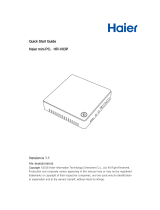
2
ZOTAC ZBOX nano
Table of Contents
Product specications -------------------------------------------------------------------------- 3
Safety information -------------------------------------------------------------------------------- 4
Setting up your system ----------------------------------------------------------------------- 4
Care during use -------------------------------------------------------------------------------- 4
Welcome --------------------------------------------------------------------------------------------- 5
Package contents ------------------------------------------------------------------------------ 5
Getting to know your ZOTAC ZBOX nano ------------------------------------------------ 6
Front view ---------------------------------------------------------------------------------------- 6
Rear view----------------------------------------------------------------------------------------- 7
How to disable integrated IR receiver ------------------------------------------------------ 8
Customizing the ZOTAC ZBOX nano ------------------------------------------------------- 9
Installing a memory module ----------------------------------------------------------------- 10
Installing a hard disk -------------------------------------------------------------------------- 11
Connecting a S/PDIF cable ------------------------------------------------------------------ 12
Setting up the ZOTAC ZBOX nano ---------------------------------------------------------- 13
Positioning the ZOTAC ZBOX nano --------------------------------------------------------- 15
Mounting the ZOTAC ZBOX nano to a LCD monitor ---------------------------------- 15
Installing drivers and software --------------------------------------------------------------- 17
Installing an operating system -------------------------------------------------------------- 17
Installing system drivers ---------------------------------------------------------------------- 17
Using your ZOTAC ZBOX nano --------------------------------------------------------------- 18
Conguring wireless connection ----------------------------------------------------------- 18
Conguring wired connection --------------------------------------------------------------- 18
Using a static IP ---------------------------------------------------------------------------- 18
Using a dynamic IP (PPPoE connection) -------------------------------------------- 19
Conguring audio output via an HDMI device ------------------------------------------ 19





















